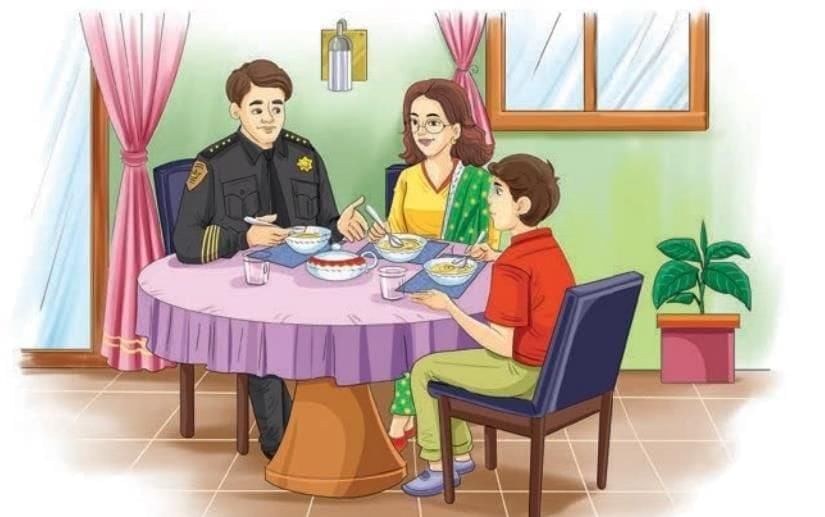Detailed Summary: The Case of the Fifth Word | Chapter Notes For Class 8 PDF Download
| Table of contents |

|
| About the Author |

|
| Key Points of the Story |

|
| Detailed Summary |

|
| Theme/ Message |

|
| Difficult Words |

|
About the Author
Donald J. Sobol was an American author best known for writing the Encyclopedia Brown series. He was born in 1924 and wrote many stories and books for children. His stories are famous for their mystery-solving style, where the reader is invited to think along with the detective. The Encyclopedia Brown books have inspired many young readers to think critically and observe the world.
 Donald J. Sobol
Donald J. Sobol
Key Points of the Story
- Encyclopedia Brown is a young boy who lives in Idaville, USA, and is known for solving mysteries.
- His father, Chief Brown, is the Chief of Police, and they often discuss cases at the dinner table.
- One day, Chief Brown brings up the death of Tim Nolan, who was previously involved in a jewellery robbery.
- Tim Nolan had a partner named Daniel Davenport, who disappeared after the robbery and was suspected of hiding stolen jewellery.
- Nolan died of a stroke, and before he passed away, he wrote a will leaving everything to Davenport.
- A sheet of paper with four strange words was found attached to the will. Chief Brown and his family were intrigued by the mysterious code.
- Encyclopedia Brown deduces that the four words are a code to reveal where the stolen jewellery is hidden.
- Nolan had written the code to help Davenport locate the jewellery, but Encyclopedia solved it first.
- He realises that the words correspond to days of the week, leading him to conclude where the jewellery is located.
- The jewellery is ultimately found under a young fir tree in Nolan's palm-tree nursery, just as Encyclopedia predicted.
- Through clever thinking and deduction, Encyclopedia helps his father solve the case, showcasing his detective skills.
Detailed Summary
Encyclopedia Brown, a young boy from Idaville, lives with his parents. His father is the Chief of Police. Although Encyclopedia is only in eighth grade, he secretly helps his father solve some of the hardest cases the police face. The Brown family often discusses mysteries at the dinner table, and that’s where the boy solves them before dessert is served.
One evening, Chief Brown comes home looking worried and announces that Tim Nolan has died. Tim Nolan had once been suspected of a jewellery robbery five years ago but was never arrested because there was no proof. Chief Brown always believed that Nolan and his friend Daniel Davenport had committed the crime together.
Nolan and Davenport had met in prison and became friends. Nolan later started a palm-tree nursery in Idaville. A week before the jewellery robbery, Davenport moved in with him. During the robbery, a clerk almost identified Nolan when his mask slipped, but she wasn’t sure enough to testify. After the robbery, Davenport vanished and was never seen again.
Chief Brown says that Nolan died of a stroke. Before dying, he left a will that gave all his property, including the nursery, to Davenport. Along with the will, there was a page from a calendar that had four strange words written on it: “Nom Utes Sweden Hurts.” Chief Brown couldn’t figure out what it meant and brought it to the dinner table for discussion.
Mrs. Brown, who used to be a teacher, tried to guess the meaning of the words but couldn’t solve the puzzle. Encyclopedia read the words carefully, closed his eyes for a moment, and asked a single question: “Is there a young fir tree in Mr. Nolan’s nursery?” Chief Brown was surprised and confirmed that there was just one fir tree near the south side of the house.
Encyclopedia explained that the four words represented the first four days of the week: Monday, Tuesday, Wednesday, and Thursday. Nolan had removed the letters ‘d-a-y’ from each day and rearranged the remaining letters to form Nom, Utes, Sweden, and Hurts. The fifth, unwritten day was Friday, represented as ‘Fir,’ pointing to the young fir tree in the nursery.
With that final clue, Chief Brown realised that the stolen jewellery must be hidden under the fir tree. When they searched the spot, they found the stolen jewellery hidden inside a 20-gallon jug of earth from which the tree was growing. Nolan intended the message for Davenport, but Encyclopedia solved the code first.
The jewellery was recovered, and the mystery was finally solved, all thanks to the clever thinking of a young detective before the soup had even gone cold.
Theme/ Message
Theme
Power of Knowledge and Intelligence - True strength lies not in age or physical power, but in sharp thinking, observation, and reasoning. Encyclopedia uses his knowledge like a tool to solve problems.
Truth and Justice - Even clever criminals like Nolan and Davenport can’t escape justice forever. With patience and intelligence, the truth always comes out.
Modesty and Humility - Despite his extraordinary abilities, Encyclopedia never boasts about solving cases. He remains humble and prefers to be seen as an ordinary boy.
Message
- The story conveys that anyone, regardless of age, can be smart and capable of solving complex problems.
- Every puzzle has a solution if approached with patience and logic.
Honesty and humility are greater virtues than pride. Encyclopedia never seeks fame, but quietly ensures that justice is done.
Difficult Words
- Detective: A person whose job is to find out information about crimes.
- Mystery: Something that is difficult to understand or explain; a puzzle.
- Evidence: Information that helps to prove something is true or false.
- Suspicious: Having doubts about someone or something; feeling that something is wrong.
- Clipped: Cut off or removed from something.
- Deduced: To come to a conclusion based on reasoning; to figure something out.
- Code: A system of words, letters, or signs used to represent something else, often kept secret.
- Nursery: A place where plants are grown and cared for before being sold or planted.
- Stroke: A medical condition in which blood flow to the brain is interrupted, causing serious health problems.
- Will: A legal document stating how a person's belongings should be distributed after they die.
- Robbery: The crime of taking something from someone by force or threat.
- Testify: To speak or give evidence in court.
FAQs on Detailed Summary: The Case of the Fifth Word - Chapter Notes For Class 8
| 1. What is the main theme of "The Case of the Fifth Word"? |  |
| 2. Who is the author of "The Case of the Fifth Word" and what is their background? |  |
| 3. What are some difficult words found in "The Case of the Fifth Word"? |  |
| 4. Can you provide a detailed summary of "The Case of the Fifth Word"? |  |
| 5. What message does "The Case of the Fifth Word" convey about communication? |  |















